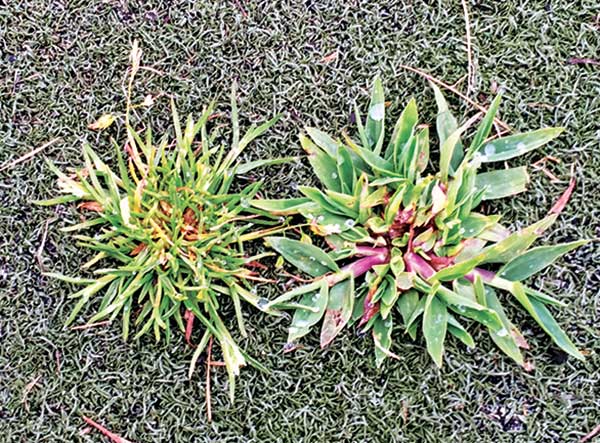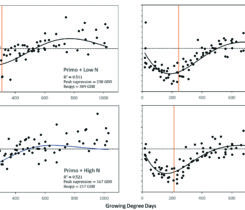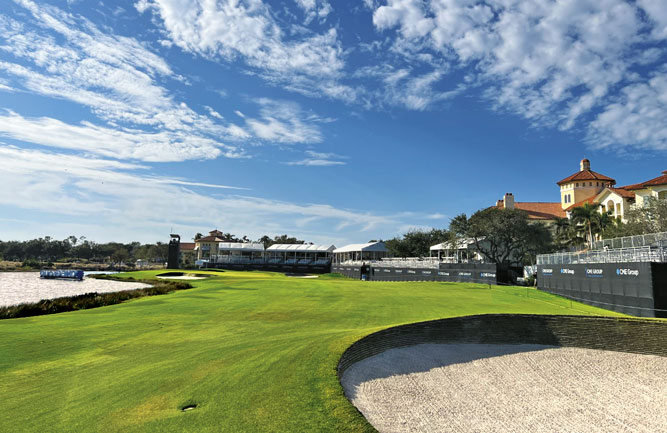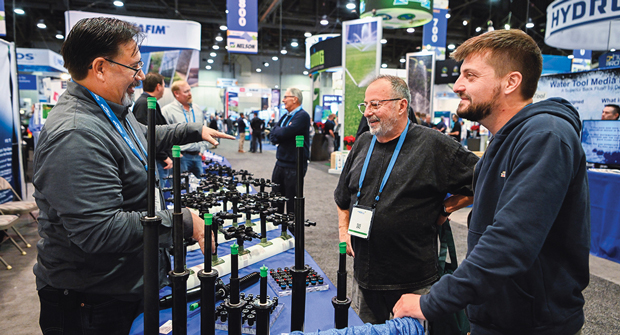Experts’ Insights: Get ahead of crabgrass

Crabgrass, as seen on this Poa annua green, can be controlled by preemergence herbicides. (Photo: Syngenta)
When it comes to crabgrass control, preemergence herbicide applications are critical. Fred Yelverton, Ph.D., professor and Extension specialist in turf and forage weed science at North Carolina State University, says superintendents should track soil temperatures in their area using data from the closest agricultural research station.
Monitoring the mean soil temperature will ensure applications hit at the most effective time. Yelverton says golf course superintendents should think about preemergence applications two weeks earlier.
“I’ve moved my recommendations for preemergence (herbicides for) crabgrass up because it is germinating earlier,” he says. “I’ve seen it germinate in North Carolina at the end of February two out of the last three years. I haven’t seen that in the previous 30 years.”
Yelverton says he’s looked at long-term climate data, and he says he’s noticed five out of the last 30 years have been the warmest years on record, and none have been the coldest years on record.
“When you drill into the data a little bit closer, what you see as the reason for the warmer temperatures is nighttime temperatures are not cooling down as much as they were,” he says. “That clearly shows a warming trend. I think this is something that’ll bounce around a bit from year to year. But I’m comfortable with moving the preemergence herbicide applications up two weeks.”
He says an early application is better than a late application because preemergent herbicides don’t break down much in the soil when temperatures are below 60 degrees F because soil microbes aren’t very active.
“There isn’t a big penalty for putting (the preemergence application) out too early, but there is a big penalty for putting the preemergence herbicide application out too late,” he says.
Beyond tracking soil temperatures, Yelverton also encourages superintendents to follow the growing degree day data.
“I don’t look at that as much for specific germination for crabgrass, but certainly growing degree days will tell you how far ahead or behind you may be,” he says.
He says at the start of this year, North Carolina was three weeks ahead of the 30-year average for growing degree days. Since then, spring had been cooler, so the state is only a little ahead of the average.

Eric Reasor (Photo: PBI-Gordon)
PBI-Gordon Corp.
Eric Reasor, Ph.D.
Southeast research scientist
Crabgrass is a summer annual grassy weed that germinates in spring when soil temperatures are 55 degrees F for several days. Most crabgrasses have a membranous ligule, hairs on the collar and pointed leaves. Maintaining an actively growing turfgrass with proper mowing, fertilization, irrigation and cultivation is the foundation of an integrated management program. Preemergence herbicides are important for managing crabgrass. Make initial applications prior to germination and then a secondary application two months later. There are also several postemergence options available. Crabgrasses can be an issue in any turfgrass situation all over the country. Furthermore, low turfgrass mowing heights allow more light into the turfgrass canopy, facilitating more germination. Turfgrasses at lower mowing heights are also less competitive against crabgrass.

Dean Mosdell (Photo: Syngenta)
Syngenta
Dean Mosdell, Ph.D.
Technical services manager
Crabgrass is one of first summer annuals to emerge in the spring. It is difficult to identify as seedlings, but easier in the multitiller stage and once inflorescence develops. The two major crabgrass species are smooth and large (hairy) crabgrass. The pubescent leaves and stems of large crabgrass help distinguish the differences between the two species. Preemergence herbicides are very effective for controlling crabgrass. Applications must be made prior to germination. Crabgrass needs light and space to develop, so manage turf to minimize voids in the turf canopy and use maximum mowing heights where feasible. Postemergence active ingredients that can control emerged crabgrass, depending on the turf species, include monosodium acid methanearsonate (where available), quinclorac and mesotrione for coolseason grasses and pinoxaden for bermudagrass and zoysiagrass.

Zac Reicher (Photo: Bayer)
Bayer
Zac Reicher, Ph.D.
Green Solutions Team specialist
Preemergence herbicides like Ronstar can be applied to both cool- and warm-season turf, but herbicides like Specticle can only be applied to warm-season turf and should be applied at least two weeks prior to expected germination. Research suggests applications can be applied to cool-season turf months prior to germination, especially in areas with light pressure or where a sequential application will be made in early summer. Sequential applications of preemergence herbicides are the most effective way to manage crabgrass in high-pressure areas from the northern Transition Zone and farther south. On occasion, crabgrass will escape a preemergence application. Herbicides with fenoxapropp-ethyl should be applied to young crabgrass for most effective control, and superintendents should include a preemergence herbicide in the tank mix through midsummer to limit future germination.

Ken Hutto (Photo: FMC Specialty Solutions)
FMC Specialty Solutions
Ken Hutto, Ph.D.
Product development manager, herbicides/fungicides
Golf course superintendents primarily deal with large and smooth crabgrass. Both have round to oval stems and tall, membranous ligules. Large crabgrass has hairs on the leaf and stem, whereas smooth crabgrass has none. Adequate fertility, irrigation and proper mowing are vital to produce a dense canopy. Preemergence herbicides with active ingredients prodiamine and sulfentrazone are effective if applications are properly timed. Postemergence herbicides with active ingredients quinclorac and sulfentrazone can be effective on crabgrass especially when targeting smaller plants. Crabgrass will infest all turfgrasses when density is reduced. In certain regions, crabgrass may not be a primary concern. Crabgrass often appears in thinned rough areas, bunker faces and practice range tees. These areas are susceptible to traffic, drought stress and excessive divots.












